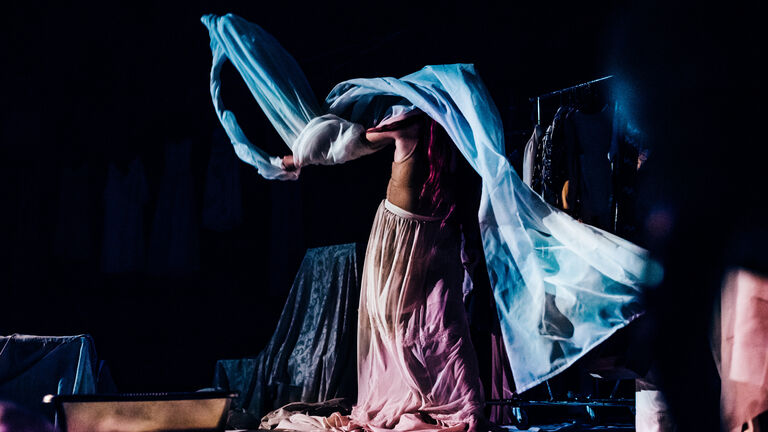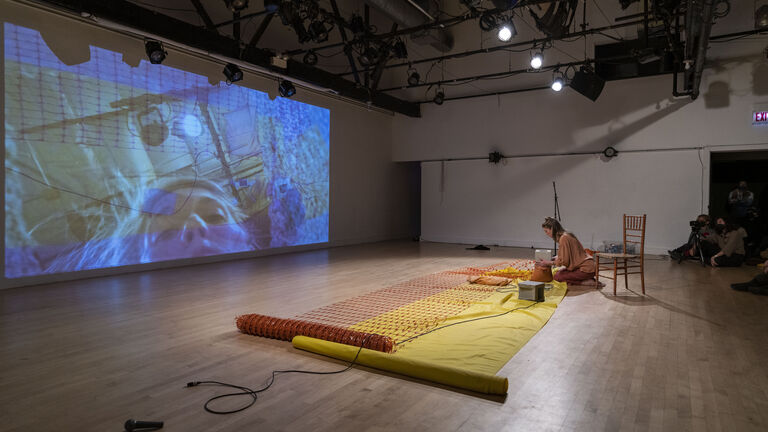
“Unravel” Madison Mae Parker (photo courtesy of the artist)
Graduate Overview
Graduate Overview
Accepting Applications
One of the only graduate-level contemporary live art departments in the country, the Performance program educates a new generation of artists who will continue to produce work that not only makes history, but makes a difference in the world.
The Performance department has a long history of producing artists who create highly experimental work that responds to radically changing concepts of the body, time-based art, social practice, new media technologies, and the social and cultural conditions of a globally mobile society. Exceeding boundaries is at the heart of the Performance department ethos, and students are encouraged to explore diverse artistic disciplines and ideas in their performance research through performance re-enactments, socially engaged/activist performance, abandoned practices, performance lectures, immersive technologies and social networking performance, tactical and site-specific performance, and choreographic actions.
Interdisciplinary Explorations and Rigorous Critique
SAIC's interdisciplinary curriculum complements the fluid nature of performance by allowing students to study in other departments and engage with graduate advisors both within and beyond the Performance department as suits their individual practices. Rigorous approaches to assessment and critique are applied throughout the program, with an emphasis on structured dialogue and response.
Professional Practice Opportunities
Department faculty are established, practicing artists with significant international reputations. The department aims to nurture students as independent practitioners and provide guidance and encouragement for showings and curatorial projects. Graduate students have the opportunity to share their work with wider audiences through public events such as the annual Fall New Blood Performance Festival and the Spring MFA Performance IMPACT Thesis Festival. Guest artists are regularly invited for symposia, workshops, and individual graduate critique sessions, including Faith Wilding, Lee Wen, Ron Athey, Jaime McMurry, Martha Wilson, Tim Miller, Sally J. Morgan, Kira O’Reilly, Vlatka Horvat, La Ribot, and Manuel Vason, as well as department alumni such as Tania Bruguera and Jillian Peña. The department also has an ongoing program of visiting representatives from organizations such as Franklin Furnace Inc. and Performa (NYC), as well as guest producers and curators from key international performance events including the SPILL International Festival of Performance (UK), City of Women (Slovenia), and the ANTI Festival (Finland), among others. In all cases, these guests engage in dialogues with students about the development of their performance practice, sharing networks and opportunities to help students find a place and role for their work in the outside world.
Possible Performance Paths
As contemporary practice moves fluidly across materials and methods, many courses at SAIC address the intersection between sculptural, performative, interactive, immersive, screen/camera/code, and material disciplines and explore their shared methods, materials, and critical/theoretical discourse.
Graduate students are encouraged to consider their art-making process as an interdisciplinary practice that can range across various departments including, but not limited to, Fiber and Material Studies; Sculpture; Performance; Fashion Design; Art and Technology / Sound Practices; Film, Video, New Media, and Animation; and Ceramics. Students are encouraged to confer with faculty and graduate advisors to map a course of interdisciplinary study that reflects the latest development in contemporary practices in these fields.
The following are some pathways to consider:
- Body/Performance: Intro to Performance; The Performing Body; Performing Next Feminisms; Movement Research/Improvisation; Bodies in Motion; Durations: Long, Medium, Short; and Movement/Presence: Body as Site
- Object Performance: Material Action, Puppetry, and Performance and Event Production
- Media Performance: Performance Media; Mixed Reality Performance; Performance and Video; Live Presence/Virtual Spaces; Performing for the Camera; and Fusions: Film, Video, Performance
- Installation/Site-Specific Performance: Site Practice; Tactical Performance; Event Production; and Performance Installation
- Collaborative Performance: Systems, Structures: Methods of Creation; Make it Strange; Collaboration/Directing for Performance; Group Work; and Between Theatre and Performance
- Critical/Activist Social and Political Performance: Extreme Bodies in Performance; Border Crossing; Performing Next Feminisms; and Tactical Performance
- Performance Writing: Body/Text; Performative Writing; Scripting/Acting for Performance; and Narrative in Performance
- Re-enactment/Reperformance: Parasitic Practices; Performing the Document; Performing Fictions; and Performance Documentation
Graduate Projects
The cornerstone of SAIC's graduate studio program is its focus on tutorially guided studio practice. Each semester, in addition to selecting from graduate advisors in the department, you will select from more than 100 graduate faculty advisors at SAIC representing myriad disciplines, approaches, and intellectual positions. Ultimately, it is the student's work that drives the choice of advisor, and both disciplinary and interdisciplinary work is supported and advanced. Faculty from the academic programs in Art History, Arts Administration and Policy, Art Education, and Visual and Critical Studies also serve as graduate advisors, providing yet more expertise in support of SAIC graduate projects.
This is the heart of your graduate study, as it gives you time to pursue your independent projects while regularly meeting with a faculty advisor. You can take up to six credits every semester, three from two advisors. We advise signing up with two different advisors each semester. For the first and second semester we strongly advise signing up with at least one advisor from the Performance department. The department chair and graduate coordinator are happy to consult with you on choosing advisors.
Critique Week
Critique Week, one of the principal means of assessment each semester, is a week-long schedule of critiques during which classes are suspended and the entire faculty and invited visiting artists and designers assemble into panels that conduct intensive studio critiques with all studio and writing graduate students.
Fall semester critiques are organized by department, with panels representing the discipline. They provide you an opportunity to have your work evaluated by the department, look at your work from a disciplinary point of view, and reinforce the expectations for your graduate study.
Spring semester critiques are interdisciplinary, with panel members of faculty, visiting artists, and peers from across SAIC departments. Interdisciplinary critiques in the spring semesters allow for a broader range of responses to the work, and are intended to assess the success of your work for a more general, yet highly informed, audience.
Studio critiques are required of every full-time graduate student pursuing an MFA in Studio or Writing degree. Typically, SAIC graduate students have at least four critique panels throughout their studies at SAIC, augmenting biweekly tutorials with their graduate advisors.
Take the Next Step
Graduate Admissions Events
Learn how to prepare a competitive application, meet with faculty and staff, and explore our programs and facilities. LEARN MORE
MFA in Studio Admissions Information
Curriculum & Courses
Continue to explore the SAIC Performance department website to learn about our curricular offerings, faculty, students, and alumni, visit the Master of Fine Arts in Studio degree program for more detailed information, or schedule a tour.
Visit the graduate admissions website or contact the graduate admissions office at 312.629.6100, 800.232.7242, or gradmiss@saic.edu.

MFA in Studio, Performance Program Brochure
“Wait, Weight Sit” Camille Casemier (photo: Eugene Tang)